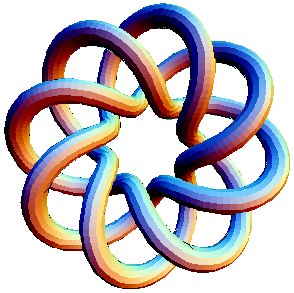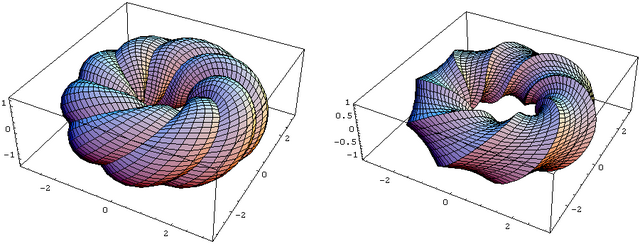0708-1300/Class notes for Tuesday, January 22
| ||||||||||||||||||||||||||||||||||||||||||||||||||||||||||||||||||||||||||||||||||||||||||||||||||||||||||||
Pictures for a Van-Kampen Computation
In[1]:=
|
<< KnotTheory`
|
Loading KnotTheory` version of January 13, 2008, 20:30:12.1353.
Read more at http://katlas.org/wiki/KnotTheory.
In[2]:=
|
TubePlot[TorusKnot[8, 3]]
|
Out[2]=
|

|
In[3]:=
|
TC[r1_, t1_,r2_,t2_ ] := {
(r1 +r2 Cos[2Pi t2])Cos[2Pi t1],
(r1 +r2 Cos[2Pi t2])Sin[2Pi t1],
r2 Sin[2Pi t2]
};
|
In[4]:=
|
InflatedTorus[p_, q_, b_] := ParametricPlot3D[
TC[
2, p t - q s,
1 + b(p^2 + q^2)s(1 - (p^2 + q^2)s), q t + p s
],
{t, 0, 1}, {s, 0, 1/(p^2 + q^2)},
PlotPoints -> {6(p^2 + q^2) + 1, 7},
DisplayFunction -> Identity
];
|
In[5]:=
|
GraphicsArray[{{InflatedTorus[3,8,1], InflatedTorus[3,8,-1]}}]
|
Out[5]=
|

|
Typed Notes
First Hour
Today's Agenda:
1) More Examples of Van-Kampen Theorem
2) More Diagrams
3) Proof of Van-Kampen (was not done)
We began by recalling the examples from last class. I will not repeat that here, merely making a few additional comments that came out:
Notation:
Technically, is poor notion as it implies that knowledge of A, B and H is sufficient to construct . In fact, we ALSO need to know the maps from H into A and B respectively in order for to be defined.
Aside
Last class we simply wrote down the schematic for the two holed torus as an octagon with the identifications on the edges given last class. We now consider how one arrives at this schematic.
To create the two holed torus one begins with two tori. One then cuts out a small open disk from each torus and then glues the two boundaries together. Let us consider what this looks like when considering a torus as the normal schematic with a square in the plane with the normal identification of the sides. Removing an open disk is equivalent to removing the inside of a loop starting at one of the corners and finishing at that same corner. This is equivalent to making a pentagon with sides where c is the added edge.
Consider two such pentagons, gluing along the edge c forms precisely the octagon we had for the two holed torus last class.
Proposition
Letting denote the g holed torus, then
(Note, I used the symbol to as the normal \ncong command doesn't seem to work. Take its meaning in context.)
Aside: Consider a functor from the category of groups to the category of Abelian groups via
If we have a (homo)morphism from then the functor takes and yields a map such that everything commutes.
Hence we know that
Of course, we need to know that in fact if
As such, since the abelianizations are not isomorphic,neither are the original groups and the spaces themselves are not homeomorphic.
Example
is of the space which can be written as a disk with two antipodal points on the boundary circle on it with the identification that the top path a (going clockwise along the boundary) is glued to the bottom path (also going clock wise). But of this is just
Claim:
Puncturing an n-manifold, , does not change . I.e., if then
Proof:
Let
= a coordinate patch about p.
Then
If n=3, as we have computed before.
Hence,
Now,
Continuing inductively the theorem holds for all n.
Aside:
If X is connected and then . I.e., it does not matter which base point we choose in a connected space, the fundamental group is invariant of this.
Proof
Consider a path from to . The returning path is denoted
Consider a loop from called .
Then get a loop from via
Similarly about
Considering the composition we get .



































